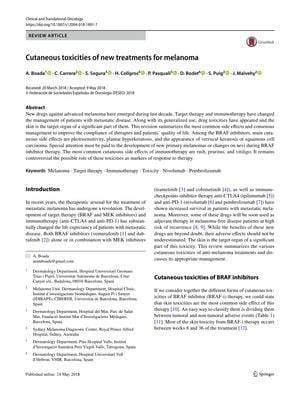Cutaneous Toxicities of New Treatments for Melanoma
May 2018
in “
Clinical & Translational Oncology
”
BRAF inhibitors MEK inhibitors immunotherapies photosensitivity squamous cell carcinoma SCC new primary melanomas vemurafenib dabrafenib combination therapy anti-PD-1 drugs rash pruritus cutaneous adverse events systemic retinoids cutaneous malignancies skin tumors skin toxicities skin-related side effects

TLDR New melanoma treatments can cause skin side effects, including skin cancer and rashes, but combining treatments may reduce these risks.
The document reviewed the skin-related side effects of new melanoma treatments, focusing on BRAF inhibitors, MEK inhibitors, and immunotherapies. It found that BRAF inhibitors can cause photosensitivity, squamous cell carcinoma (SCC), and new primary melanomas, with SCC occurring in 21-31% of patients on vemurafenib and 6-11% on dabrafenib. Combination therapy with BRAF and MEK inhibitors was shown to reduce the incidence of skin tumors. Immunotherapy, particularly anti-PD-1 drugs, led to milder cutaneous adverse events like rash and pruritus, but also more severe conditions in some cases. The document emphasized the need for dermatologic evaluation and management in patients receiving these treatments and suggested that as immunotherapy use increases, so will the incidence of skin toxicities. It also mentioned the effectiveness of systemic retinoids in preventing cutaneous malignancies in patients on BRAF inhibitors and highlighted the importance of collaboration between dermatologists and oncologists.




